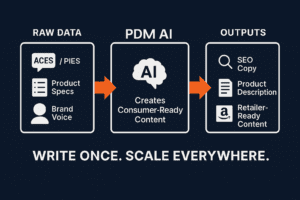Crafting a compelling story will help position your brand and its products as leaders in the automotive industry.
When a potential customer lands on your page, whether it’s your website or an eCommerce giant like Amazon or Walmart, the product description must convey what the product is, what it fits, and, most importantly, why your product is best. If you miss any of these elements, your description will fall flat, causing buyers to leave your page for better, more compelling results. It’s imperative to remember that well-written copy is especially critical if you offer a premium automotive product or a product with a rich heritage that commands a higher price.
Those few seconds that the consumer spends with your product are crucial. Here’s how to make every second and every word count.
Understanding Your Audience
Every business sells to a target audience, but strategically speaking, understanding your audience is especially important in the automotive industry.
Unlike other businesses, the automotive industry encompasses customer-facing repair shops, home mechanics, and DIY enthusiasts working on their own vehicles. Each one of these audiences will have a different set of expertise and a different reason for buying a particular product. For example, someone who owns an automotive repair shop might be more interested in the cost of a product, shipping speed, or the warranty offered versus a DIY enthusiast who will be more interested in a product’s appearance, quality, or performance.

Understanding your brand’s target audiences will help you craft your copy in a way that lands with a high level of effectiveness. This “selling to the needs” technique is the basis of all solid sales organizations.
Key Elements Necessary In Every Product Description
Now that you have your audience in mind, your product description will need several more critical elements to make it stand out.
Title
A clear and informative title is the first step in creating a compelling product description for auto parts. It sets the stage for the customer’s expectations and helps attract the right audience.
Vehicle Compatibility
Detailed information on vehicle compatibility ensures that customers can quickly determine if the auto part fits their vehicle model, reducing the likelihood of returns due to compatibility issues. This information is pulled from ACES and PIES data, and companies like PDM Automotive make managing and distributing this data a snap.
High-Quality Images
Alongside a strong title, the importance of including high-quality images cannot be overstated. Detailed photos from multiple angles allow customers to inspect the product closely, offering them a virtual touch-and-feel experience crucial in online shopping. Digital catalogs perform this task with ease.
Photos can be the difference between success and failure in the aftermarket, especially if you sell products designed to enhance a vehicle’s appearance, such as custom wheels or other exterior accessories.
Features and Specifications
Highlighting the part’s technical specifications and unique features is crucial in educating the customer about what makes the product stand out. This includes detailing the benefits, which is essential in explaining how the product solves a problem or enhances the customer’s experience, making it easier to justify the purchase.
Pro Tip: Buyers have short attention spans, so keep this information quick and punchy to maximize effectiveness.
Warranties and Certifications
Discussing quality standards, certifications, or awards associated with the product builds trust and credibility. It reassures customers about the quality and reliability of the auto part, making them more confident in their purchase decisions. Warranties are also crucial because products that offer solid warranties convey trust to the buyer and position your company as a leader in the industry that stands behind its products.
These elements together form the backbone of a product description that informs, persuades, and assures the customer, making it an indispensable tool for automotive aftermarket business owners aiming to improve their online sales and customer satisfaction.
Using Visuals and Multimedia
Enhancing product descriptions with diagrams, exploded views, or videos that showcase the part in action elevates the customer experience.
Visual aids turn complex information into accessible, engaging content. By seeing the part from every angle or in motion, customers understand how it fits and functions within their vehicle. Visuals are compelling for explaining intricate products or installation processes.
A video or diagram can convey in seconds what might take paragraphs to describe, breaking down barriers to comprehension. They aid decision-making and reduce the likelihood of returns by ensuring customers know exactly what they’re buying and how to use it.
This approach doesn’t just sell a product; it educates and empowers your customers, fostering confidence and trust in your brand.
Writing Tips for Compelling Descriptions
Crafting your product descriptions with clear and concise language is critical to grabbing attention.
Every word counts in making your product stand out. But it’s not just about being brief; it’s about being powerful. Inject your copy with keywords for SEO to ensure your products shine in search results but keep the flow smooth and the reading experience enjoyable. Bullet points are your ally, breaking down technical specs and features into digestible bits that readers can quickly scan and understand.
But don’t just list features; weave them into a compelling narrative that speaks directly to your buyer’s needs and desires. Show them how your auto part isn’t just another item—it’s the solution they’ve been searching for. Steer clear of industry jargon that could alienate those not well-versed in auto lingo. Make your descriptions accessible and inviting to all. Don’t forget to add that extra value by including installation tips or links to guides.
Make your product descriptions informative and indispensable, turning casual browsers into confident purchasers.
Leveraging Storytelling
Sharing the story behind your product or brand adds a layer of authenticity and depth that can significantly boost customer trust and engagement. When people understand the passion, innovation, or craftsmanship that goes into creating each auto part, they’re not just buying a product but becoming part of your story. This emotional connection can transform a simple transaction into a loyal customer relationship.
Incorporating testimonials or reviews into your product descriptions leverages the power of social proof, reinforcing the decision to buy with evidence of others’ positive experiences. These firsthand accounts act as a vote of confidence from the community, reassuring potential buyers that they’re making a wise choice. By showcasing real stories of satisfaction and success, you’re not just selling auto parts; you’re offering peace of mind and the promise of a positive outcome.
Optimization and Testing
A/B testing transforms guesswork into strategy, letting you fine-tune your product descriptions based on actual customer responses. This approach zeroes in on what makes your audience tick, optimizing your messaging to boost engagement and sales. It’s a direct line to understanding and leveraging customer preferences, ensuring your descriptions don’t just talk but resonate.
Staying on top of product changes and insights keeps your descriptions fresh and relevant. Regular updates signal to customers that you’re attentive and committed to quality, enhancing trust and loyalty. This isn’t just maintenance; it’s an ongoing effort to showcase your best, ensuring your products always hit the mark in the fast-paced market.
Elevate Your Automotive Aftermarket Presence with PDM Automotive
Complete and engaging product descriptions are crucial in the automotive aftermarket, bridging the gap between the specifications of your products and what your customers are looking for. By harnessing engaging copy and visuals, you can elevate your online presence, turning interest into sales.
PDM Automotive seamlessly integrates into this strategy, providing a platform that optimizes and propagates your product descriptions across all sales channels for maximum brand control and visibility. With PDM Automotive, streamlining your product content management becomes effortless, paving the way for growth and success in the competitive automotive aftermarket landscape.

More Resources
Elevate Your Brand in the Automotive Aftermarket With These Content Management Strategies



